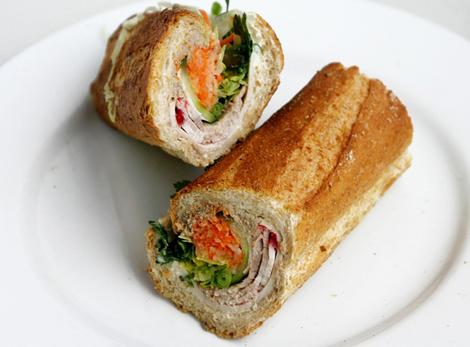Not since the advent of sushi has a single food so taken the United States by storm.
If you haven’t yet had a bánh mě—a Vietnamese stuffed baguette—you might now be in the American minority. While long popular in immigrant communities, sold inexpensively at noodle shops and corner stores, the sandwich was, until recently, hardly known outside the Vietnamese population. But within the last few years, the sandwich’s popularity has exploded—spawning specialty shops from New York to New Orleans, emerging from high-end restaurant kitchens, and even turning up on American bar food menus.
Why all the excitement? Though often cheap and quickly thrown together, a well-made bánh mě is a marvel of taste and texture. Evolving in French-occupied Indochina, the sandwich incorporates ingredients from both French and local culinary traditions. Onto a crusty rice-flour baguette, also called a bánh mě, are piled roasted pork, picked carrots and radish, fresh sliced cucumber, cilantro, Vietnamese ham, jalapeńo peppers, and often a spread of liver pâté and a swipe of spicy mayonnaise.
There are many variations on the classic bánh mě—some with meatballs, or chicken, or scrambled egg. But in almost every case, the crunchy baguette, fresh vegetables, fatty meats, and rich pâté deliver an exciting, conflicting, but ultimately harmonious mouthful.

In New York, shops like
Baoguette (which just opened its third location) and
Hanco’s in Boerum Hill have earned immediate followings for their specialty bánh mě. David Chang of the
Momofuku empire has had bánh mě on his late-night menu. New York also introduced us to the sandwich's Cambodian incarnation with
Num Pang, selling baguettes stuffed with catfish, coconut shrimp, or tender pork belly.
Northern California chain
Lee’s Sandwiches has expanded across the Southwest to Texas, Arizona and Oklahoma. New York bars like
Blue Seats and
Blind Tiger Ale House serve bánh mě right alongside the quesadillas and buffalo wings. And in the ultimate sign of cultural penetration, Tom Colicchio, of
Craft Restaurants and Top Chef fame, has already
declared the bánh mě "over."
As a culinary trend, the bánh mě may have hit its peak. But as a sandwich newly embraced by the American masses, its reign seems far from over.